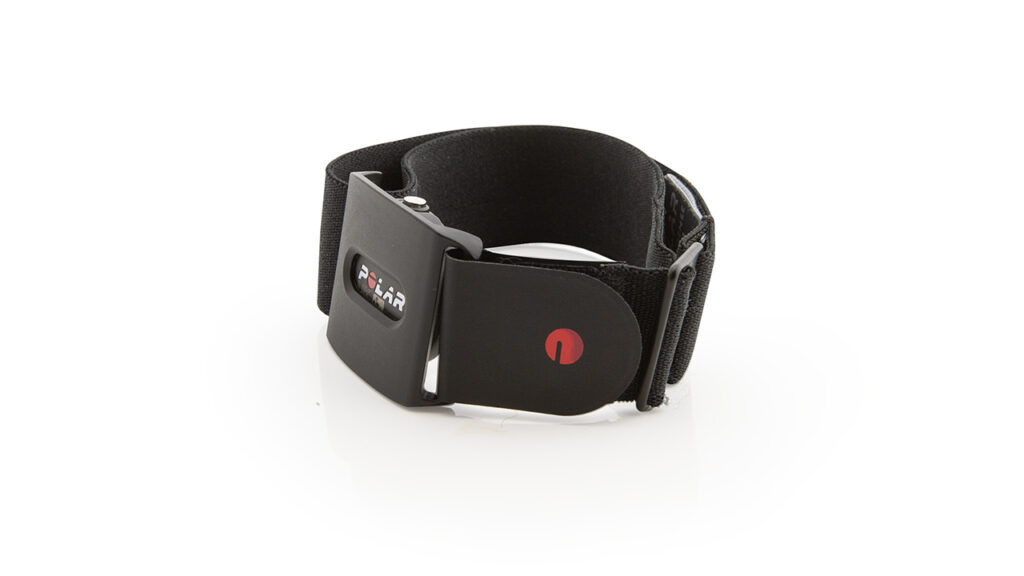Go Wireless® Optical Heart Rate User Manual
Order Code: GW-OHR
The Vernier Go Wireless Optical Heart Rate is a wireless chest strap that measures heart rate on a mobile device. It provides a convenient, hands-free solution for continuously monitoring heart rate before, during, and after exercise—or while stationary. It connects via Bluetooth® wireless technology to compatible devices.
Note: Vernier products are designed for educational use. Our products are not designed nor are they recommended for any industrial, medical, or commercial process such as life support, patient diagnosis, control of a manufacturing process, or industrial testing of any kind.
What’s Included
- Optical Heart Rate Straps
- Polar Transmitter Module
- USB charging dongle
Compatible Software and Interfaces
Compatible devices for connection via Bluetooth wireless technology include LabQuest® 2 or newer, Chromebook™, macOS® and Windows® computers, iPadOS™, and iOS and Android™ mobile devices.
Getting Started
Place the Polar® Transmitter Module into the USB charging dongle and charge the sensor for at least 4 hours prior to first use. Ensure that the indicator light comes on and blinks to verify that the sensor is charging. The sensor is fully charged when the light is green and steady.
Locate and record the ID on the side of the Polar Transmitter Module. This is a unique sequence of eight numbers and/or letters (e.g., ID:XXXXXXXX).Turn the Polar Transmitter Module on with one short push of the button on the side of the sensor. Attach the Polar Transmitter Module to the Optical Heart Rate Strap securely. Secure the strap around the subject’s arm. Verify that the Polar Transmitter Module is against the skin. The sensor is now ready for data collection.
Collecting Data with Vernier Graphical Analysis
- Launch Vernier Graphical Analysis®.
- Select Sensor Data Collection. Choose Wireless.
- Select the Polar HR with the proper ID from the list of available sensors.
- Tap Collect to begin data collection.
Note: When done collecting data, tap Disconnect. This will make the sensor available for other devices. If the connection between the device and the sensor is lost, tap Connect and select your Polar HR sensor. Important: When finished, turn off the Polar Transmitter Module with a long push of the button on the side. This sensor must be turned off when finished, as it has no auto-shut off.
Collecting Data with LabQuest App
- Choose New from the File menu. On the Meter screen, choose Wireless Device Setup ► Go Wireless from the Sensors menu.
- Select the Polar HR with the proper ID from the list of available sensors. Select OK.
- The heart rate of the subject will be displayed on the Meter screen.
- Collect data as desired.
Note: When done collecting data, tap Disconnect. This will make the sensor available for other devices. Tap Connect and select your Polar HR sensor. Important: When finished, turn off the Polar Transmitter Module with a long push of the button on the side. This sensor must be turned off when finished, as it has no auto-shut off.
Placement of the Sensor
To measure heart rate accurately, you need to wear the provided armband snugly on your forearm or upper arm, not on your wrist.
The armband holder also functions as a signal booster. For best Bluetooth transmission range, always use the sensor in the provided armband holder.
Specifications
Polar Transmitter Module
|
Battery type |
Rechargeable (non-removable) |
|
Battery life per charge |
~30 hrs |
|
Operating temperature |
–10 to 50 ºC |
|
Radios |
Bluetooth |
|
Wireless range |
30 m unobstructed |
How the Sensor Works
The Go Wireless Optical Heart Rate measures a person’s heart rate by detecting the movement of blood under the skin with each heart beat using light reflectance. LEDs emit green light, which is reflected back to a photodiode. The heart rate information is then wirelessly transmitted using a Bluetooth radio to capable devices running Graphical Analysis or to LabQuest 2 or 3.
Charging the Battery
Before charging, please make sure there’s no moisture, dust or dirt on the charging contacts of your Go Wireless Optical Heart Rate and USB charging adapter. Gently wipe off any dirt or moisture. Do not charge the sensor when it’s wet. Do not charge the battery in temperatures under 0 °C/ +32 °F or over +40 °C/ +104 °F or when the USB port is wet.
Attach the USB charging adapter to the sensor before connecting the adapter to the power supply. Don't leave the USB charging adapter connected to the power supply without the sensor. The Go Wireless Optical Heart Rate has an internal, rechargeable battery. Use the USB charging adapter included in the product set to charge it via the USB port on your computer.
You can charge the battery via a wall outlet. When charging via a wall outlet, use a USB power adapter (not included in the product set). If you use a USB power adapter, make sure that the adapter is marked with "output 5Vdc" and that it provides a minimum of 500mA. Only use an adequately safety-approved USB power adapter (marked with "LPS", "Limited Power Supply", "UL listed, or “CE”).
To charge, just plug your Go Wireless Optical Heart Rate and charging dongle into your computer or a USB power wall outlet: :
- Place the sensor into the USB adapter with the lens facing up so that the contacts on the sensor and USB adapter meet.
- Plug the USB adapter into a computer USB port or USB power wall outlet
Note: If the battery is completely empty, it can take several minutes for battery charging to start. Do not leave the battery fully discharged for a long period of time or keep it fully charged all the time, because it may affect battery life.
Button Functions and LEDs
Side button
- Turn the sensor on by pressing the button shortly.
- Turn the sensor off by pressing and holding the button.
Battery status
- Battery low: Red LED blinks slowly
- Battery critical: Red LED blinks quickly
Battery Status when Charging
When charging, the status LED blinks certain colors to indicate the battery status of the sensor:
|
Red |
0–9% |
|
Orange |
10–29% |
|
Yellow |
30–79% |
|
Green |
80–99% |
|
Green LED is continuously on when the battery is full |
|
Care and Maintenance
- Keep the optical sensor area clean and scratch-free. Scratches and dirt will reduce the performance of the optical heart rate measurement.
- Avoid using perfume, lotion, suntan/sunscreen or insect repellent on the area where you wear the sensor. If the sensor comes into contact with these or any other chemicals, wash it with a mild soap and water solution and rinse well under running water.
- Rinse the sensor after each lab session with lukewarm tap water. Clean the sensor with a mild soap and water solution when needed. Never use alcohol or any abrasive material.
- Rinse the armband after each lab session. You can wash the armband in a washing machine. Do not use bleach or fabric softener.
- Do not charge the sensor when it’s wet.
- Do not charge the battery in temperatures under 0 °C / +32 °F or over +40 °C / +104 °F.
- If you are going to store the Optical Heart Rate sensor for several months, it is recommended to recharge it after a few months. This will prolong the battery lifetime.
Storage
Keep your device in a cool and dry place. Do not keep it in a damp environment. Do not expose the device to direct sunlight for extended periods. It is recommended to store the training device partially or fully charged. The battery slowly loses its charge when it is stored. If you are going to store the device for several months, it is recommended to recharge it after a few months. This will prolong the battery lifetime. Do not leave the device in extreme cold (below –10 °C/14 °F) and heat (above 50 °C/120 °F) or under direct sunlight.
Troubleshooting
For troubleshooting and FAQs, see www.vernier.com/til/25767
Accessories/Replacements
| Item | Order Code |
|---|---|
| Polar Replacement Charging Dongle |
OHR-CRG |
| Optical Heart Rate Strap |
OHR-STRAP |
Disposal
When disposing of this electronic product, do not treat it as household waste. Its disposal is subject to regulations that vary by country and region. This item should be given to an applicable collection point for the recycling of electrical and electronic equipment. By ensuring that this product is disposed of correctly, you help prevent potential negative consequences on human health or on the environment. The recycling of materials will help to conserve natural resources. For more detailed information about recycling this product, contact your local city office or your disposal service.
 The symbol, shown here, indicates that this product must not be disposed of in a standard waste container.
The symbol, shown here, indicates that this product must not be disposed of in a standard waste container.
Warranty
Warranty information for this product can be found on the Support tab at www.vernier.com/gw-ohr/#support
General warranty information can be found at www.vernier.com/warranty
Contact Support
Fill out our online support form or call us toll-free at 1-888-837-6437.

